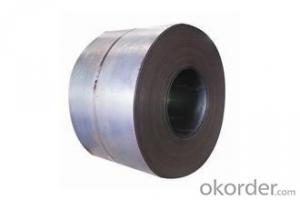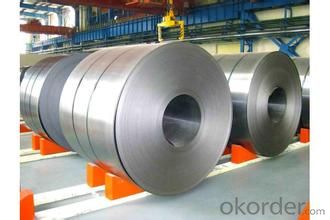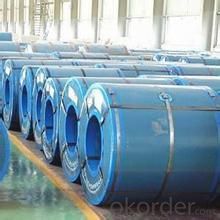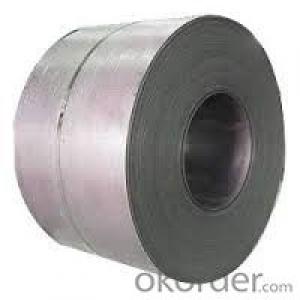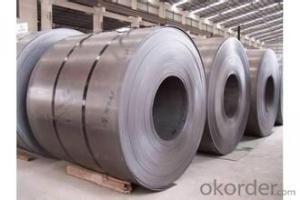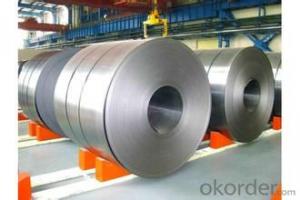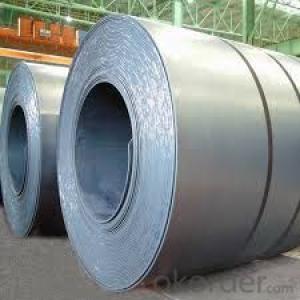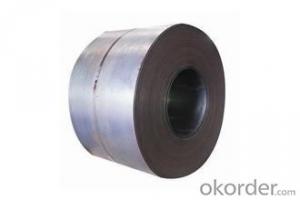Stainless Steel Coil/Sheet/Strip/Sheet /Steel - G3131-SPHC
- Loading Port:
- China main port
- Payment Terms:
- TT OR LC
- Min Order Qty:
- 20 m.t.
- Supply Capability:
- 500000 m.t./month
OKorder Service Pledge
OKorder Financial Service
You Might Also Like
Product Description:
Hot Rolled Stainless Steel Coil 304 Annealing and Pickling No.1 Finish
Stainless steel is a production which not easy rust,acid resistance and corrosion resistance,so it is widely
used in light industry,heavy industry,daily necessities and the decoration industry.
Hot Rolled Stainless Steel Coil 304 Physical Properties
Tensile strength σb (MPa) ≥ 520
the conditions yield strength σ0.2 (MPa) ≥ 205,
elongation δ5 (%) ≥ 40
Reduction of ψ (%) ≥ 50,
hardness: ≤ 187
HB; ≤ 90
HRB; ≤ 200H
We can ensure that stable quality standards are maintained, strictly meeting both market requirements and customers’ expectations. Our products enjoy an excellent reputation and have been exported to Europe, South-America, the Middle-East, Southeast-Asia, Africa and Russia etc.. We sincerely hope to establish good and long-term business relationship with your esteemed company.
Our Hot-Rolled Steel Sheets and Coils are applied to a wide range of uses such as automobile, electrical appliance, machinery manufacturing, container manufacturing, shipbuilding, bridge, pipeline, and receive high acclaim from our customers for its excellent quality.
- Q: How are steel coils inspected for uniformity using statistical analysis?
- Steel coils are inspected for uniformity using statistical analysis by randomly selecting a sample of coils and measuring specific characteristics such as thickness, width, and weight. These measurements are then analyzed using statistical methods, such as mean, standard deviation, and control charts, to determine if the coils meet the desired uniformity criteria. This approach allows for efficient and reliable assessment of the overall quality and consistency of steel coils.
- Q: hi to every one I need to konw moer about steel and iron industry (process) thank you in advance for your intresting
- Steel is made from injecting air into molten iron
- Q: How are steel coils inspected for dimensional accuracy after processing?
- Steel coils are inspected for dimensional accuracy after processing using various methods such as measuring tape, calipers, laser scanners, or automated vision systems. These tools allow for precise measurements of the coil's width, thickness, and length, ensuring that it meets the required specifications.
- Q: How are steel coils inspected for impact resistance using impact testers?
- To assess the impact resistance of steel coils, specialized machines called impact testers are utilized. These machines are designed to evaluate the coils' ability to endure impacts. The process involves subjecting the coils to controlled impacts and measuring the resulting deformation or damage. Initially, the steel coils are securely positioned and oriented on the impact tester. This ensures accuracy and consistency. The tester is equipped with a striking element, like a pendulum or falling weight, which applies a specific force upon impact. The element is aligned precisely with the steel coil for precise testing. Once the setup is complete, the impact tester is activated, and the striking element is released to impact the steel coil. The force of the impact is carefully controlled and measured to ensure consistency across multiple tests. The tester records various parameters, including applied force and impact duration. After the impact, the steel coil undergoes a thorough examination for visible deformation or damage. This includes checking for dents, cracks, or any signs of structural compromise. The extent of the deformation or damage is recorded and compared to predetermined acceptance criteria to determine if the coil passes or fails the impact resistance test. To gather additional data during testing, impact testers can be equipped with various sensors and cameras. High-speed cameras capture the impact in slow motion, allowing for detailed analysis of the coil's behavior. Strain gauges can also be attached to the steel coil to measure strain and stress experienced during the impact. In conclusion, the use of impact testers offers a reliable and standardized method for inspecting the impact resistance of steel coils. By subjecting the coils to controlled impacts and accurately measuring deformation or damage, manufacturers can ensure that their steel coils meet the required impact resistance standards for different applications.
- Q: I don't know why but I'm having a VERY difficult time finding the melting point of 1008 steel.
- It is still the same for 1008 steel. Go to the bottom and see the listing of the grades it covers. Since the only difference between the 1006 and 1008 steel is a few micro amounts of alloys and by far the greatest majority or main component is iron (99%), as a general melt temperature , 2750 F is the melt temperature at which the other alloys are added to the charge to fine tune the mix. Just like adding salt to distilled water actually lowers the boiling point of water, adding alloys to iron decreases the melting point of iron. The iron melts at 2800F, but once alloys to make the 1008 grade are added, it decreases melt temp to 2750F. Since the melting point of pure iron is 2800F, the temperature is actually decreased by adding these impurities of alloys. These alloys are tested while the mix is starting to come down from a pure melt, steel is sampled. and then alloys below are checked and added to make the 1008 steel. The steel is maintained at 2750 F so that the less volatile alloys don't boil off before combining with steel. Minimum Properties Ultimate Tensile Strength, psi 43,900 - 51,900 Yield Strength, psi 26,100 - 34,800 Elongation 42 - 48% Chemistry Iron (Fe) 99% Carbon (C) 0.08% Manganese (Mn) 0.6% max Phosphorus (P) 0.035% max Copper (Cu) 0.2% min Sulfur (S) 0.04%
- Q: How are steel coils used in the production of wind turbine components?
- Steel coils are an essential component in the production of wind turbine components. These coils are typically made from high-strength steel, which is known for its durability and ability to withstand harsh weather conditions. One of the primary uses of steel coils in wind turbine production is in the manufacturing of the tower. The tower is the structure that supports the entire wind turbine, and it needs to be strong enough to withstand the weight of the nacelle and the rotor blades. Steel coils are used to fabricate the sections of the tower, which are then assembled to create a tall and sturdy structure. Another crucial application of steel coils is in the production of the rotor blades. The rotor blades are responsible for capturing the wind's energy and converting it into rotational motion. Steel coils are used in the manufacturing of the blade's internal structure, known as the spar, which provides strength and rigidity to the blade. The coils are shaped and formed into the desired blade shape, and then composite materials are added to enhance its aerodynamic properties. Furthermore, steel coils are also utilized in the production of other wind turbine components such as the hub and the nacelle. The hub is the central part of the rotor, to which the blades are attached, and it requires a strong and reliable steel structure to sustain the immense forces generated by the rotating blades. The nacelle, on the other hand, houses the generator and other vital components of the wind turbine, and steel coils are used in its construction to ensure stability and protection. In summary, steel coils play a crucial role in the production of wind turbine components. From the tower to the rotor blades, hub, and nacelle, steel coils provide the necessary strength, durability, and stability required to withstand the demanding conditions of wind energy production. Without these coils, the construction and operation of wind turbines would not be possible, as they form the backbone of these renewable energy systems.
- Q: What are the different methods of laminating steel coils?
- There are mainly three methods of laminating steel coils: the hot-dipped galvanizing method, the electro-galvanizing method, and the cold-rolled laminating method. The hot-dipped galvanizing method involves dipping the steel coils into a bath of molten zinc, which forms a protective layer on the surface. The electro-galvanizing method uses an electric current to deposit a thin layer of zinc onto the steel coils. Lastly, the cold-rolled laminating method involves pressing together layers of steel with an adhesive layer in between to create a laminated coil. These methods help enhance the durability, corrosion resistance, and overall quality of the steel coils.
- Q: i have recently gotten into DIY and am planning on making my own knife. My question is what kind of steel would be good to use for heat treating if i plan on using water and not oil in the process.
- Go to junkyard get old leaf spring, cut out knife, start sharpening. Why waste time heat treating steel when the spring steel as already be done.
- Q: What is future prospect of these steel structures, are they really weather proof like everyone believes??
- you are doubting the steel structure building? Well, not every compay can give the same steel building, come to Muyang, it can give you best steel structure building.
- Q: What are the challenges in coil edge trimming for narrow strips?
- There are several challenges in coil edge trimming for narrow strips. Firstly, one of the main challenges is maintaining accuracy and precision during the trimming process. Narrow strips require a high level of precision to ensure that the edges are trimmed evenly and smoothly. Any deviation from this precision can result in uneven edges or burrs, which can affect the overall quality of the strip. Secondly, there is the challenge of controlling the strip tension. Narrow strips are more prone to tension issues, as they have less surface area to distribute the tension evenly. This can lead to problems such as strip breakage or stretching, which can impact the final product's quality. Another challenge is avoiding material waste. Narrow strips often have a smaller margin for error, meaning that any mistakes in the trimming process can result in a significant amount of wasted material. Minimizing material waste is crucial for cost-effectiveness and sustainable manufacturing practices. Additionally, maintaining a high production rate can be challenging when working with narrow strips. The trimming equipment needs to be able to handle the high speed required for efficient production while still maintaining accuracy and precision. This requires the use of advanced machinery and technology to ensure smooth and efficient operations. Lastly, the handling and transportation of narrow strips can also pose challenges. Due to their small size, narrow strips are more susceptible to damage during handling and transportation. Proper care and handling techniques need to be implemented to prevent any potential damage, which could affect the quality of the final product. Overall, the challenges in coil edge trimming for narrow strips revolve around precision, tension control, material waste, production rate, and handling. Overcoming these challenges requires the use of advanced technology, skilled operators, and careful attention to detail throughout the entire process.
Send your message to us
Stainless Steel Coil/Sheet/Strip/Sheet /Steel - G3131-SPHC
- Loading Port:
- China main port
- Payment Terms:
- TT OR LC
- Min Order Qty:
- 20 m.t.
- Supply Capability:
- 500000 m.t./month
OKorder Service Pledge
OKorder Financial Service
Similar products
Hot products
Hot Searches
Related keywords
